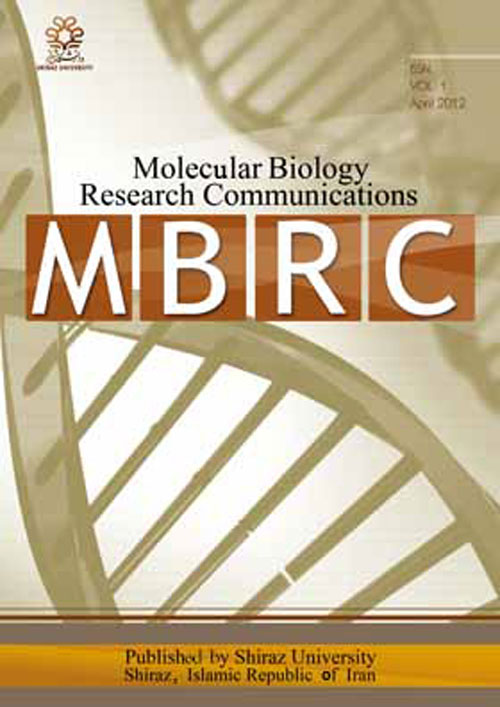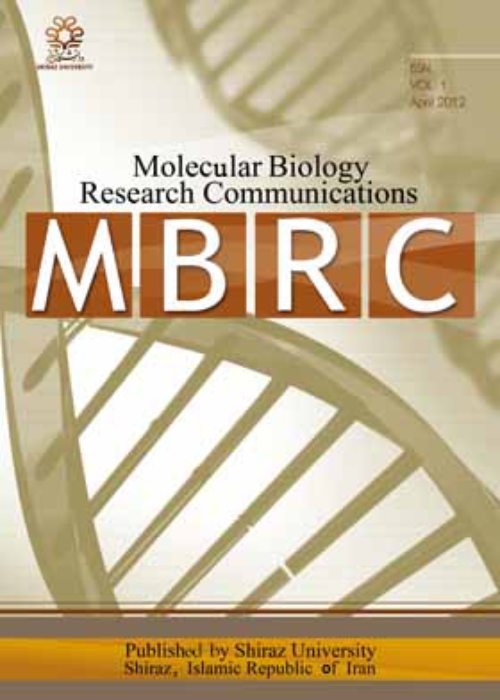فهرست مطالب

Molecular Biology Research Communications
Volume:5 Issue: 1, Mar 2016
- تاریخ انتشار: 1394/12/25
- تعداد عناوین: 7
-
-
Pages 1-10L-asparaginase has lots of medical and industrial applications. Ever since L-asparaginase anti-tumor activity was first demonstrated, its production using microbial systems has attracted considerable attention owing to their cost-effective and eco-friendly nature. The aim of this study is to obtain L-asparaginase producing bacteria and determining the enzyme activity. Samples were picked up from Jooshan hot springs located in the Sirch, Kerman. The L-asparaginase producing bacteria were screened on the agar medium supplied with L-asparagine and phenol red indicator dye (pH-7.0). L-asparaginase activity was detected on the basis of pink color around the colony. Enzyme production was also performed based on ammonia detection by Nessler method. Among 24 strains, there were 7 strains which could produce L-asparaginase.Sequencing of 16S rRNA showed that, the best isolates producing L-asparaginase belongs to the Pseudomonas genus. Enzyme activity after 24 and 48 h of incubation showed that Pseudomonas pseudoalcaligenes strain JHS-71was the best strain that produced L-Asparaginase about 240 (U/ml) after 48h of incubation. Results showed that, L-Asparaginase activity enhanced about 27% in the presence of Co. L-asparaginase JHS-71 retained more than 50% of its initial activity in the presence of Cu, Mn, Zn, Mg and Fe. Because of various applications of L-asparaginase in biotechnology, P. pseudoalcaligenes strain JHS-71 can be used as a suitable candidate in these fields.Keywords: L, Asparaginase, Pseudomonas, Sirch hot, spring, Screening, Identification
-
Pages 11-17Nonalcoholic fatty liver disease (NAFLD) is an obesity-associated disease and dysregulation of adipokines has an important role in its development. Omentin-1 (ITLN1 protein) and resistin are two adipokine secreted from adipose tissue. Single nucleotide polymorphisms in the adipokine genes may affect expression and activity of the adipokine, and thus play a contributory role in NAFLD pathogenesis. The aim of the present study was to investigate the association between omentin-1 rs2274907 (326A/T) and resistin rs1862513 (-420 C/G) polymorphisms and risk of NAFLD in Iranian patients. This case-control study was done on 282 subjects included 94 patients with NAFLD and 188 healthy peoples. The genotypes were determined using PCR-RFLP method. The frequency of omentin-1 AT genotype in patients with NAFLD was significantly different from that in the control (OR=2.3, 95% CI: 1.3-3.8, P=0.003). A significant association was observed between NAFLD and the GG genotype regarding resistin rs1862513 polymorphism (OR=2.3, 95% CI: 1.1-4.8, P=0.03). In conclusion, Omentin-1 rs2274907 and resistin rs1862513 polymorphisms might be a candidate genetic factor for susceptibility to NAFLD.Keywords: Non, alcoholic fatty liver disease, Polymorphism, ITLN, Resistin
-
Pages 19-30HTLV-1 and HIV-1 are two major causes for severe T-cell leukemia disease and acquired immune deficiency syndrome (AIDS). HTLV-1 protease, a member of aspartic acid protease family, plays important roles in maturation during virus replication cycle. The impairment of these proteases results in uninfectious HTLV-1virions.Similar to HIV-1protease deliberate mutations that confer drug resistance on HTLV-1 are frequently seen in this protease. Therefore, inhibition of HTLV-1 protease activity is expected to disrupt HTLV-1s ability to replicate and infect additional cells. In this study, we initially designed fifteen inhibitory compounds based on the conformations of a class of HIV-1 aspartyl protease inhibitors, sulfonamid-peptoid. Five compounds were chosen based on the goodness of their Drug-Likeness scoreusing Lipinsks rule of five. Here, using protein-ligand docking approach we compared the inhibitory constants of these compounds to those available in literatures and observed significantly higher inhibition for two compounds, SP-4 and SP-5. Our data suggest that the addition of two cyclic hydrocarbons to both ends of sulfonamide peptoids leads to the formation of new hydrophobic interactions due to the semi-circular form of these compounds, connecting the first chain of protease to the two ends of tested ligands via Hydrophobic interactions. We conclude that hydrophobic force plays an important role in suppressing protease activity especially for HTLV-1 protease, which in turn prevents the virus maturity. Therefore, designing and development of new ligands based on aromatic hydrocarbons in both ends of inhibitors is very promising for efficient treatment.Keywords: HTLV, 1 protease, HIV protease, Molecular dynamics dimulation, Docking, Drug design
-
Pages 31-43Multiple gene silencing is being required to target and tangle metabolic pathways in eukaryotes and researchers have to develop a subtle method for construction of RNA interference (RNAi) cassettes. Although, several vectors have been developed due to different screening and cloning strategies but still some potential limitations remain to be dissolved. Here, we worked out a simple cloning strategy to develop multisite small interfering RNA (siRNA) cassette from different genes by two cloning steps. In this method, effective siRNA sites in the target messenger RNAs (mRNAs) were determined using in silico analysis and consecutively arranged to reduce length of inverted repeats. Here, we used one-step (polymerase chain reaction) PCR by designed long primer sets covering the selected siRNA sites. Rapid screening, cost-effective and shorten procedure are advantages of this method compare to PCR classic cloning. Validity of constructs was confirmed by optimal centroid secondary structures with high stability in plants.Keywords: Cloning strategy, Computational modeling, One, step PCR method, siRNA, targeting cassette
-
Pages 45-48Recently, inflammation has been found to be a significant factor in the development of Schizophrenia (SCZ). The aim of the present research was to investigate whether interleukin-33 (IL-33, OMIM: 608678) gene polymorphism (rs11792633, C/T) is associated with the development of SCZ or not.DNA was isolated from the serum of 70 patients with SCZ and 70 healthy controls. The PCR based method was used for detection of the IL-33 polymorphism. The CT (OR=0.05, 95% CI: 0.003-0.057, PKeywords: IL, 33, Polymorphism, Schizophrenia
-
Pages 49-57Colorectal cancer (CRC) is a third most common epithelial carcinoma. CRC is known to develop from the early precancerous lesion to full blown malignancy via definite phases due to cumulative mutations and aberrant methylation of number of genes. The use of serum biomarkers that is non-invasive to discriminate cancer patients from healthy persons will prove to be an important tool to improve the early diagnosis of CRC. This will serve as the boon to the clinical management of the disease.Keywords: Colorectal Cancer, Epigenetics, Hypermethylation, Biomarkers
-
Pages 59-64Glutathione S-transferases (GSTs; EC: 2.5.1.18) are a ubiquitous family of eukaryotic and prokaryotic phase II metabolic isozymes. Genes encoding GSTM1 (OMIM: 138350), and GSTT1 (OMIM: 600436) are members of class mu and theta, respectively. The most common polymorphism in the GSTM1 is a deletion of the whole GSTM1 gene with a lack of enzyme activity. A homozygous deletion in the GSTT1 has also been reported (null genotypes of GSTT1). The aim of the present study was to investigate the association between GSTM1 and GSTT1 polymorphisms and risk of dependency to opium sap. The present study was performed in Shiraz (southern Iran). In total, 71 males dependent to opium sap and 590 healthy males (as a control group) were included in this study. The genotypes of GSTM1 and GSTT1 polymorphisms were determined by PCR. Our data indicate that neither GSTM1 (OR=0.78, 95% CI: 0.47-1.27, P=0.325) nor GSTT1 (OR=1.25, 95% CI: 0.70-2.21, P=0.442) null genotypes significantly associated with the risk of opium sap dependence. There is no additive effect of the null genotypes of GSTT1 and GSTM1 in relation to the risk of dependency to opium sap. The present study indicated that the null genotypes of GSTT1 and GSTM1 are not risk factor for opium sap dependence.Keywords: GSTM1, GSTT1, Opium sap dependence, Polymorphism


